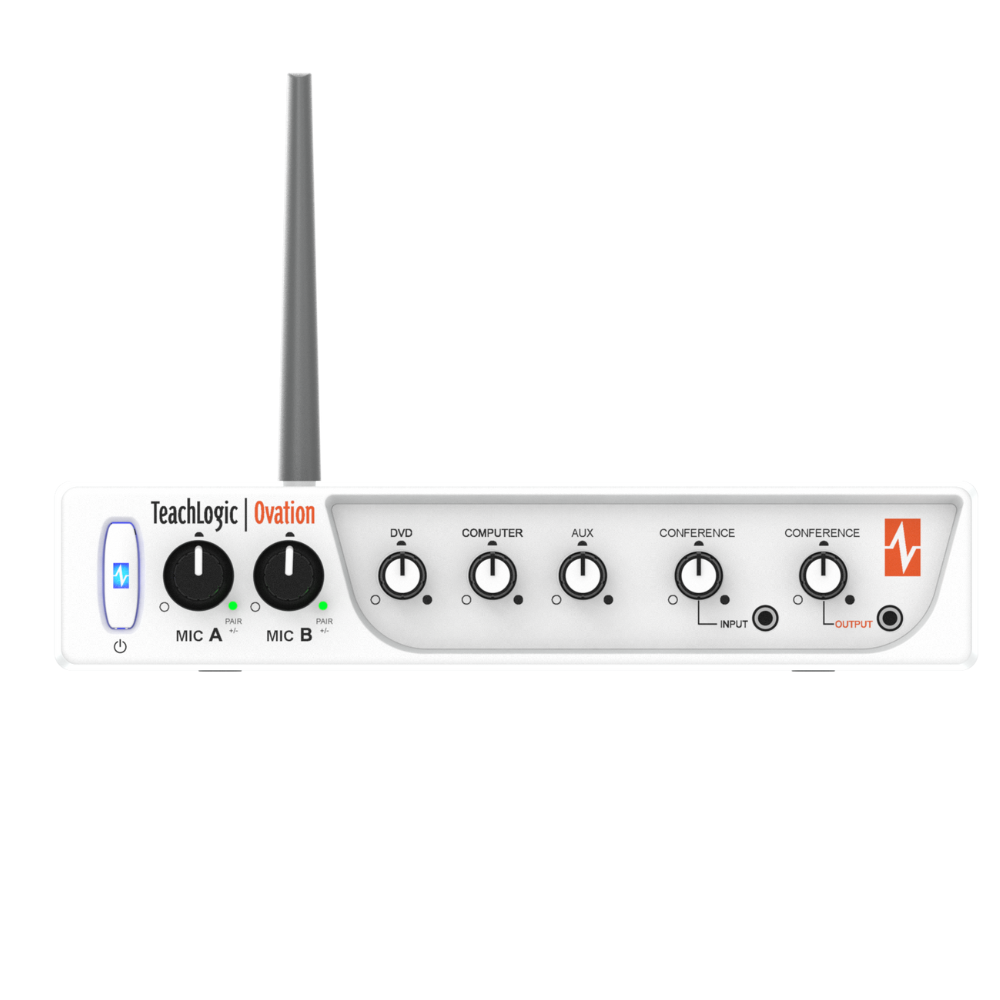Classroom Audio Solutions
Simple, affordable classroom audio that supports teachers and empowers students.
TeachLogic systems offer classroom audio solutions that ensure an equal sound experience for all in classrooms, conferences, and assemblies. By establishing a “Soundfield,” our systems provide an even distribution of Audio throughout the room. Ensuring that everyone hears every word of the lesson or lecture without straining the speaker’s voice.
Why choose Classroom Audio?
Classroom audio systems amplify the teacher’s voice through speakers, transmitters, and a microphone, creating an even sound field. This reduces vocal strain, allows teachers to move freely, and keeps students engaged—leading to better focus, improved comprehension, and higher academic performance.
Easy to Use
TeachLogic systems are designed for seamless integration into any classroom, with intuitive controls that make setup and operation simple for educators..
Cost Effective
Providing high-quality sound distribution at an affordable price, TeachLogic enhances learning while offering a budget-friendly solution for schools.
Proven Academic Gains
Studies show that improved classroom audio leads to better student engagement, comprehension, and overall academic performance. We ensures every student hears clearly, leading to greater learning success.
Choose the Right System
Selecting the right TeachLogic™ system starts with understanding your school’s unique needs and preferences. Our feature comparison table below breaks down the key features of each TeachLogic™ model, simplifying the process of identifying the optimal solution for your needs.

Portable System
Quantum II™-
Self-Contained Plug-and-play Instruction
-
Hearing Assistance Connection
-
2 Audio Inputs
-
Small Room (Less than 900ft2)

Infrared (IR) Systems
Maxim™, Matrix™, Spectrum™-
Life & Safety Alert (Except Forum)
-
Hearing Assistance Connection
-
2-4 Audio Inputs
-
Regular to Large Room (900 ft2 Number of Students 11+)

DECT (RF) System
Ovation™-
Life & Safety Alert
-
Hearing Assistance Connection
-
4 Audio Inputs
-
Regular Room (Size: 900-1600 ft2 Number of students: 11-32)
Tailored to your needs, whether you’re seeking a portable solution, infrared, or DECT technology, we’ve got you covered. Plus, our systems can integrate with safety, fire alarms, and connect to computers for remote learning or smartboards for panel audio amplification.
Need to connect with an existing Assistive Listening System? Seeking a portable, scalable option to accommodate various group sizes and needs? TeachLogic® offers complete flexibility allowing venues to use the TeachLogic and Williams AV systems for various applications.
Ready to Learn More?
FAQs
An effective system evenly distributes all classroom audio sources so every student hears equally well.
A classroom Sound Field System is a compact PA system designed for classrooms (up to 1000 sq ft) to enhance voice clarity and audio distribution from various sources like TVs, projectors, and computers.
Sound Field vs. Sound Amplification:
Though similar in hardware, Sound Field systems differ in two key ways:
Even Sound Distribution: Multiple overhead speakers (ideally four for up to 1600 sq ft) ensure uniform sound coverage, unlike a single speaker that leaves some areas lacking.
Teacher Microphone: It’s not about volume but clarity. A mic ensures the teacher’s voice is heard consistently despite classroom noise, reverberation, and movement.
Why 65 dB?
Classroom noise averages 50 dB, and studies show a 15 dB signal-to-noise ratio is needed for clarity—meaning the teacher’s voice and all audio must reach 65 dB at students’ ears, not just at the source.
The Role of a Microphone:
Normal speech is 50-60 dB, and even loud speech (65 dB) drops to 53 dB at 12 ft, making it barely audible over background noise like HVAC (50 dB).
A microphone ensures consistent sound levels and preserves high-frequency consonants, which are crucial for comprehension. Instead of just making speech louder, it makes it clearer—as if the teacher is speaking just a few feet away from every student.
Classroom Sound Field System benefits a wide range of individuals by ensuring clear, evenly distributed audio throughout the room.
Students
Improved Comprehension: Clearer speech enhances learning, especially for students sitting farther away.
Support for Hearing Challenges: Beneficial for students with hearing impairments or auditory processing disorders.
Reduced Listening Fatigue: Less strain to hear the teacher, improving focus and engagement.
Teachers
Less Vocal Strain: A microphone prevents teachers from having to raise their voices all day.
Consistent Audio Delivery: Ensures every student hears instructions clearly, regardless of movement or classroom noise.
Enhanced Classroom Management: Reduces the need to repeat information, keeping students more engaged.
Schools & Administrators
Better Academic Performance: Studies show improved comprehension and retention with better sound clarity.
Inclusive Learning Environment: Supports diverse learning needs, ensuring equitable access to instruction.
Long-Term Cost Savings: Reduces teacher absenteeism due to vocal strain and supports accessibility requirements.
A Sound Field System is not just about volume—it’s about clarity, engagement, and accessibility for all learners.
loud voice doesn’t guarantee clear speech. A Classroom Sound Field System ensures even distribution of your voice so every student hears all components of speech accurately.
Consonants Matter: Volume alone doesn’t amplify consonants, which are crucial for understanding speech.
Less Strain, More Clarity: Instead of shouting, let the system enhance clarity, making it easier for students to focus.
Consistent Sound for All: Whether students sit in the front or back, they hear the same level of detail.
A Sound Field System isn’t about being louder—it’s about making sure every word is heard clearly. Learn more about Sound Field today!
Many studies can be downloaded from our website under Research Studies.
